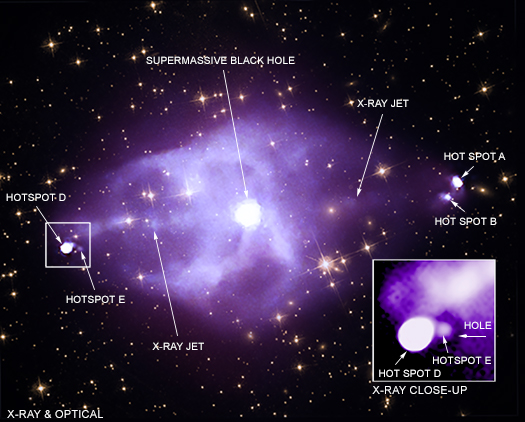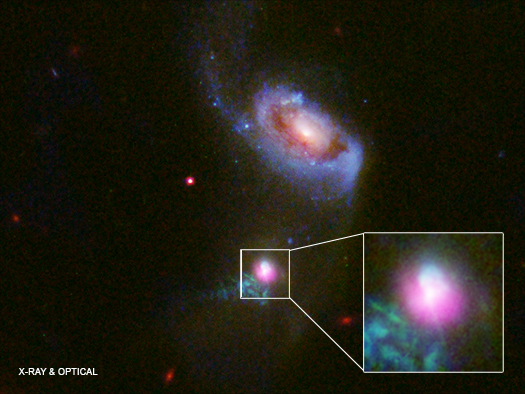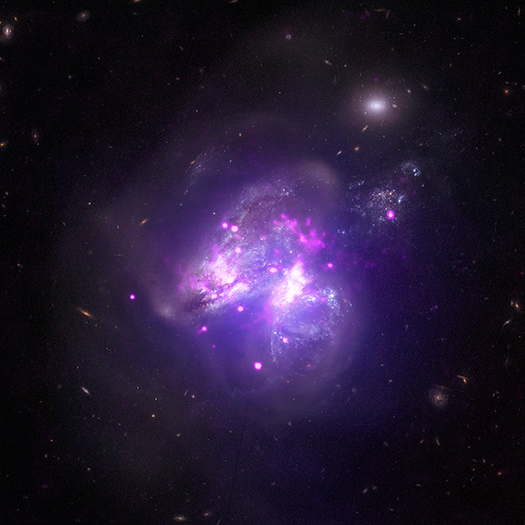Quasars & Active Galaxies
Storm Rages in Cosmic Teacup
Submitted by chandra on Thu, 2019-03-14 09:31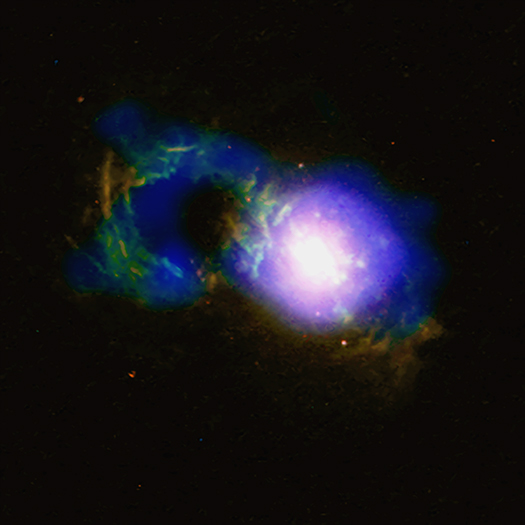
The Teacup, SDSS J1430+1339
Credit: X-ray: NASA/CXC/Univ. of Cambridge/G. Lansbury et al; Optical: NASA/STScI/W. Keel et al.
Fancy a cup of cosmic tea? This one isn't as calming as the ones on Earth. In a galaxy hosting a structure nicknamed the "Teacup," a galactic storm is raging.
The source of the cosmic squall is a supermassive black hole buried at the center of the galaxy, officially known as SDSS 1430+1339. As matter in the central regions of the galaxy is pulled toward the black hole, it is energized by the strong gravity and magnetic fields near the black hole. The infalling material produces more radiation than all the stars in the host galaxy. This kind of actively growing black hole is known as a quasar.
Hide and Seek: Tracking Down the Invisible Filaments
Submitted by chandra on Fri, 2019-02-15 08:40
Orsolya Kovács
We welcome Orsolya Kovács, a third-year PhD student at the Eötvös Loránd University, Hungary where she obtained her MSc degree in astronomy, as our guest blogger. Currently, she is a pre-doctoral fellow at the Smithsonian Astrophysical Observatory, and is the first author on a recent paper on the WHIM featured in our latest press release.
I was working on a totally different subject before I started the missing baryon project with a small group of scientists at the Smithsonian Astrophysical Observatory (SAO) about two years ago. Before I came to the United States as a Ph.D. student, I was involved in analyzing optical data of variable stars observed at the beautiful Piszkéstető Station in the Mátra Mountains, Hungary. In my master’s thesis, I focused on the variable stars of an extremely old open cluster in the Milky Way, and at that time, I also got the chance to gain some observing skills from my Hungarian supervisor.
So the very beginning of my astronomy career was all about optical astronomy. But before getting really into optical astronomy and mountain life, I decided to interrupt this idyllic period, and find some new challenges: I wanted to spend part of my Ph.D. years learning X-ray astrophysics. With this in my mind, I applied to the SAO’s pre-doctoral program, and a few months later I arrived in Massachusetts.
Shortly after introducing me to the basics of X-ray astronomy, Ákos Bogdán at SAO proposed a crazy idea about how to observe the ‘invisible’, i.e. the missing part of the ordinary (baryonic) matter that could possibly solve the long-standing missing baryon problem. The missing baryon problem is related to the mismatch between the observed and theoretically predicted amount of matter.
Where is the Universe Hiding its Missing Mass?
Submitted by chandra on Wed, 2019-02-13 14:42New results from NASA's Chandra X-ray Observatory may have helped solve the Universe's "missing mass" problem, as reported in our latest press release. Astronomers cannot account for about a third of the normal matter — that is, hydrogen, helium, and other elements — that were created in the first billion years or so after the Big Bang.
Scientists have proposed that the missing mass could be hidden in gigantic strands or filaments of warm (temperature less than 100,000 Kelvin) and hot (temperature greater than 100,000 K) gas in intergalactic space. These filaments are known by astronomers as the "warm-hot intergalactic medium" or WHIM. They are invisible to optical light telescopes, but some of the warm gas in filaments has been detected in ultraviolet light. The main part of this graphic is from the Millenium simulation, which uses supercomputers to formulate how the key components of the Universe, including the WHIM, would have evolved over cosmic time.
Cygnus A: Ricocheting Black Hole Jet Discovered by Chandra
Submitted by chandra on Tue, 2019-01-08 11:13A ricocheting jet blasting from a giant black hole has been captured by NASA's Chandra X-ray Observatory, as reported in our latest press release. In this composite image of Cygnus A, X-rays from Chandra (red, green, and blue that represent low, medium and high energy X-rays) are combined with an optical view from the Hubble Space Telescope of the galaxies and stars in the same field of view. Chandra's data reveal the presence of powerful jets of particles and electromagnetic energy that have shot out from the black hole. The jet on the left has slammed into a wall of hot gas, then ricocheted to punch a hole in a cloud of energetic particles, before it collides with another part of the gas wall.
Playing it Safe: Chandra's Return to Science Observations
Submitted by chandra on Thu, 2018-11-01 12:26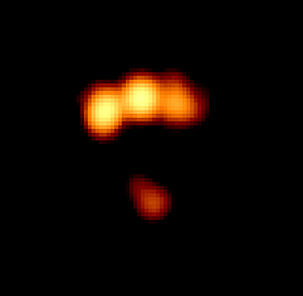
Credit: NASA/CXC/Trinity University/D. Pooley et al.
On October 10th, NASA’s Chandra X-ray Observatory went into “safe mode,” following a glitch on one of the telescope’s gyroscopes. After hard work by the team at the Chandra X-ray Center, the problem was identified and solved, allowed Chandra to resume science observations less than two weeks later on October 21st.
One of the first targets that Chandra looked at after its return to science was PS 0147+4630, a gravitationally-lensed quasar. What is that exactly? A quasar is a supermassive black hole that is rapidly consuming gas from its surroundings. The gas falls into a disk around the black hole where it becomes hot and generates prodigious amounts of radiation. Gravitational lensing is a phenomenon, first predicted by Einstein, where light from a very distant source is bent by a massive intervening object, such as a large galaxy or a galaxy cluster. This creates multiple images of a single, faraway object and amplifies the brightness of the light, acting in some ways as a natural magnifying glass.
Finding the Happy Medium of Black Holes
Submitted by chandra on Wed, 2018-08-08 16:43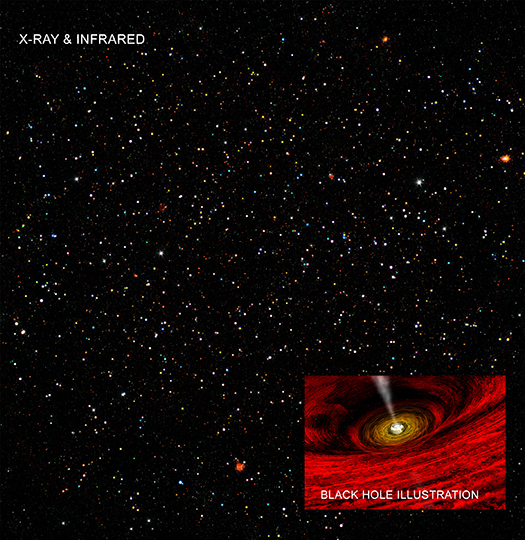
Credit: X-ray: NASA/CXC/ICE/M.Mezcua et al.;
Infrared: NASA/JPL-Caltech; Illustration: NASA/CXC/A.Hobart
This image shows data from a massive observing campaign that includes NASA's Chandra X-ray Observatory. These Chandra data have provided strong evidence for the existence of so-called intermediate-mass black holes (IMBHs). Combined with a separate study also using Chandra data, these results may allow astronomers to better understand how the very largest black holes in the early Universe formed, as described in our latest press release.
The COSMOS ("cosmic evolution survey") Legacy Survey has assembled data from some of the world's most powerful telescopes spanning the electromagnetic spectrum. This image contains Chandra data from this survey, equivalent to about 4.6 million seconds of observing time. The colors in this image represent different levels of X-ray energy detected by Chandra. Here the lowest-energy X-rays are red, the medium band is green, and the highest-energy X-rays observed by Chandra are blue. Most of the colored dots in this image are black holes. Data from the Spitzer Space Telescope are shown in grey. The inset shows an artist's impression of a growing black hole in the center of a galaxy. A disk of material surrounding the black hole and a jet of outflowing material are also depicted.
Researchers Catch Supermassive Black Hole Burping — Twice
Submitted by chandra on Thu, 2018-01-11 16:28Using data from several telescopes including NASA's Chandra X-ray Observatory, astronomers have caught a supermassive black hole snacking on gas and then "burping" — not once but twice, as described in our latest press release.
This graphic shows the galaxy, called SDSS J1354+1327 (J1354 for short) in a composite image with data from Chandra (purple), and the Hubble Space Telescope (HST; red, green and blue). The inset box contains a close-up view of the central region around J1354's supermassive black hole. A companion galaxy to J1354 is shown to the north. Researchers also used data from the W.M. Keck Observatory atop Mauna Kea, Hawaii and the Apache Point Observatory (APO) in New Mexico for this finding.
Chandra detected a bright, point-like source of X-ray emission from J1354, a telltale sign of the presence of a supermassive black hole millions or billions of times more massive than our sun. The X-rays are produced by gas heated to millions of degrees by the enormous gravitational and magnetic forces near the black hole. Some of this gas will fall into the black hole, while a portion will be expelled in a powerful outflow of high-energy particles.
Giant Black Hole Pair Photobombs Andromeda Galaxy
Submitted by chandra on Wed, 2017-11-29 11:20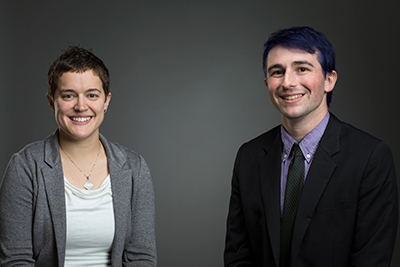
Professor Emily Levesque & Trevor Dorn-Wallenstein
Trevor is a third-year Astronomy graduate student at the University of Washington in Seattle, working with Professor Emily Levesque. He led the paper that is the subject of our latest press release on the discovery of a giant black hole pair that is photobombing the Andromeda Galaxy. He is interested in massive stars and young stellar populations, as well as playing the drums and baking cookies.
It’s funny how a simple case of mistaken identity can lead to the discovery of exotic objects hiding as unassuming dots in the sky.
My advisor, Professor Emily Levesque, and I, both astronomers at the University of Washington, were interested in finding star systems called red supergiant X-ray binaries. These systems consist of a compact object, like a neutron star or black hole, and a red supergiant — massive stars like Betelgeuse that are 10-20 times the mass of our sun but much less hot. Mass from the supergiant is lost to the compact object, where it should heat up and glow brightly in X-rays. While no such systems have been conclusively identified, red supergiant X-ray binaries could be used to better understand the evolution of the most extreme star systems.
Arp 299: Galactic Goulash
Submitted by chandra on Mon, 2017-06-26 15:45What would happen if you took two galaxies and mixed them together over millions of years? A new image including data from NASA's X-ray Observatory reveals the cosmic culinary outcome.
Arp 299 is a system located about 140 million light years from Earth. It contains two galaxies that are merging, creating a partially blended mix of stars from each galaxy in the process.
However, this stellar mix is not the only ingredient. New data from Chandra reveals 25 bright X-ray sources sprinkled throughout the Arp 299 concoction. Fourteen of these sources are such strong emitters of X-rays that astronomers categorize them as "ultra-luminous X-ray sources," or ULXs.
These ULXs are found embedded in regions where stars are currently forming at a rapid rate. Most likely, the ULXs are binary systems where a neutron star or black hole is pulling matter away from a companion star that is much more massive than the Sun. These double star systems are called high-mass X-ray binaries.
Pages
Please note this is a moderated blog. No pornography, spam, profanity or discriminatory remarks are allowed. No personal attacks are allowed. Users should stay on topic to keep it relevant for the readers.
Read the privacy statement



